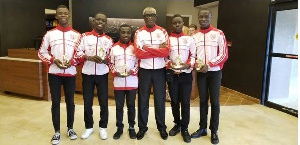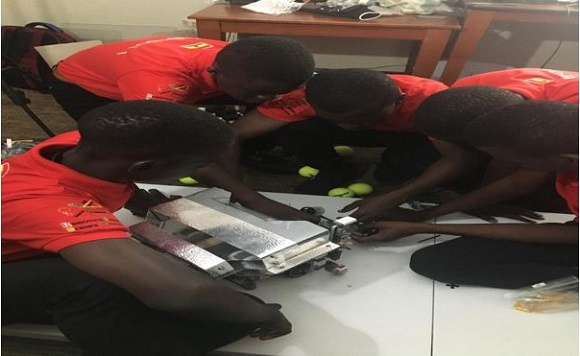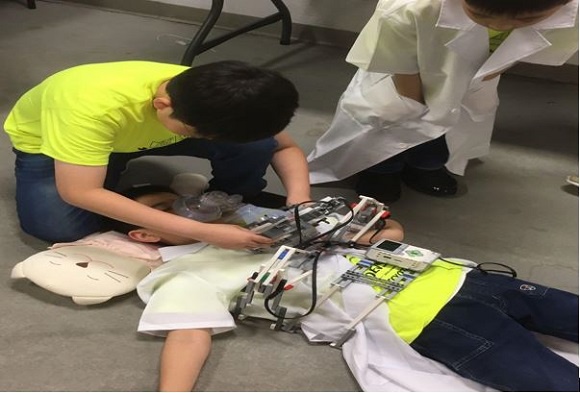 GiantBot1 members displaying their participation trophies.
GiantBot1 members displaying their participation trophies.
On Thursday May 17th, I set off to Southfield, Michigan to witness the 19th Edition of Robofest obviously because my former school GSTS was participating in the Championship. According to the website of organizers (https://www.robofest.net/), “Robofest is a festival of competitions and events with autonomous robots that encourages students to have fun while learning principles of Science, Technology, Engineering, and Math (STEM) and Computer Science. Students design, construct, and program the robots.”
I had been planning this five (5) hour trip from Toronto, Canada since learning that GSTS had qualified to the robotics world stage (with two other Ghanaian schools). It would be an understatement to say that, I was eagerly looking forward to seeing the Ghanaian teams and their coaches showcase their skills to the world. During the my five hour drive, I thought about what this competition was going to be like, how our Ghanaian teams would fare against their counterparts from across the globe and what this meant for STEM education at GSTS and in Ghana.
Upon arrival, I met up with Giantbot1 for dinner and retired to my room to get some rest. The main plan for the next day, Friday 18th May, was to go to the competition venue to do some trial runs with the robot. The GSTS team/robot is aptly named Giantbot 1. Apt, because GSTS alumni call themselves Giants, so it is only natural to name their robots - Giantbots. Since GSTS was presenting only one team, they called themselves Giantbot 1. It might interest readers to know that GSTS have on some occasions presented up to three (3) teams at national robotics competitions. In fact, Giantbot1, Giantbot2 and Giantbot3 are currently the Gold, Silver and Bronze Champions in the Autonomous Rescue Competition (ARC) in Ghana.
I woke up on Friday to join two other alumni (Giant Tetteh Abbeyquaye’89 and Giant Leonard Wilson’74), and the team in their hotel (practice) room where they had already begun testing out their robot. We observed quietly as the team problem solved through glitches and fine-tuned the robot. At one point, the robot started behaving erratically. After some discussion, the students determined that it was due to weak batteries that should have been charged overnight. Immediately, all available batteries were put on chargers. On another occasion, it was some key part in the robot’s arm coming off after several trial runs. As I stood quietly watching the students at work, I said to myself that maybe robots also get tired. Some of the other team members were putting final touches to the robot’s tray designed to carry tennis balls as they get picked up by the robot (a key task for the competition). As an observer, watching robotics up-close for the first time, I was fascinated by a number of things these students were developing; consciously or unconsciously.
First was teamwork, then programming, then problem-solving skills and finally leadership, as this was a mostly student driven activity. Throughout the day, all of the above mentioned elements were on full display over and over. At 4 pm when we left for Lawrence Technological University to try the robot out under competition conditions.

Teamwork - GiantBot1 members working on the arms of their robot.
At the venue, we met the Opoku Ware Senior High School (OWASS) and Right to Dream Academy teams who had also come in to do some test runs. Just like us, they had some alumni around and there were also, a number of Detroit-based Ghanaians present to give all the team moral support. While the alums and supporters interacted with each other, the teams kept working on their robots to fine tune them for the big day.
From my perch, I noticed that all the teams had work to do as the robots were doing what was expected. Our Giantbot1’s robot was still experiencing some glitches that were difficult to explain. The tennis balls were not always being picked and delivered into the overhead tray of the robot. At times, the balls were bumped off the table. Fine tuning and test runs continued until around 8 pm when we had to leave the venue for it to be setup for actual competition the next day. By this time, we had been joined by more Ghanaians and Giants. Just before it was time to leave, all the Ghanaians around got together for a group photograph and listened to a short welcome address by Professor Gregory Yawson, a Ghanaian Chemistry Professor at Lawrence Technological University.
After that, we all left the venue and headed back to the hotel, stopping in between to have a bite. It was at that point, that we realized some of us had not eaten all day. The task ahead seemed enormous and everyone was focused on seeing their team’s robots execute admirably, or to perfection at the competition the following day.
After dinner, Giantbot1 team members immediately went back to work. They set up their tables, bottles and balls in their practice room and continued testing the robot. As late as 10pm they were still working on fine tuning the robot. Personally, this is where I had a new level of respect for the two captains Kelvin Oduro Aboagye and Kelvin Nketia-Achiampong. They would not stop, they wanted their robot to be perfect even though they seem to be dealing with things beyond their control. Perseverance and determination was written all over their faces. I have always respected Giant Coach Boafo enormously, but my respect went up even more. Although tired and struggling to stay awake, he was awake just to provide some moral support as the boys worked into the night. This made me also come to appreciate what coaching a robotics team really meant. It is not a job for the faint-hearted, it requires stamina, patience, dedication and commitment.
We, the Giants around bid the team goodnight around 10:30pm and left them with their coach. At 3:30 am, Giant Abbeyquaye’89 who had been with the team in Southfield since Thursday, had to return home to Massachusetts. On the way to the airport, he, and Giant George Andoh’89’91 decided to pass by the Gt. Boafo’s room to bid goodbye. To their surprise, the two Captains and their Coach were wide awake, still working to fine tune the robot to pick the balls and stay within the boundaries of the field. At this point, they insisted that the team had to get some sleep no matter the stage of their fine tuning. With some reluctance, they agreed and eventually retired to bed.
At approximately, 6:30am, I was up and at the team’s door together with Giant Idun Lee’80’82 and Giant Tony Ashon’81. We helped them get ready and transported them to the venue of the games by 8am. After arriving, the team did a few trials and was ready for the competition. By this time, I had a sense that the Giantbot1 robot may have a tough time finishing its task due to the hitches I had witnessed the previous day. Coach Boafo’80’82 had told us the previous day that this situation of robots not performing as expected is familiar with the team. Sometimes, the same programs and robots will execute to perfection but at critical moments during competitions or just before, the same robot with the same software and program could malfunction. In spite of this, we were somewhat hopeful. When the trial runs before the competition begun, I started to witness other teams experiencing problems with their tasks as well. So maybe, it was not only us, I thought to myself.
The opening ceremony begun at 9am prompt with a flag ceremony parading all countries represented at the Championship. Then, all the coaches and spectators were asked to step out, leaving only team members and games officials in the arena to go over the rules of the game. During this time, the game officials revealed the “final unknown task” that all robots were to execute during their runs. When all spectators were called back, it was clear that all the teams were ready to deliver on their months of hard work and preparation.
Video of GiantBot1 being programmed for the unknown task
The Ghanaian schools competed in the senior category of “the GAME”, the main attraction of the world championship. Two teams were called in at a time, over two rounds, and the final score was based on the average scores for the two rounds.
Finally, the long awaited competition was upon us; rules had been set and the teams were ready. Teams started activating their robots for the first round; and from the get go, some robots simply froze after moving only a few inches from the start point. It was both nerve wracking and interesting to witness how the teams reacted. Many days of practice only to have your robot freeze at the start?
I soon realized that for some teams, there was a strategy at play. I believe some robots were designed to accomplish at most 50% of the task at hand while others were designed to accomplish 100%. Our GiantBot1 was in the latter group, designed to accomplish 100% of the task, that is, identify balls, pick all balls, dump them in a box, push the bottles off the table and then execute the final unknown task all autonomously. With my mind racing in all directions, it dawned on me that there was a need for pragmatism depending on your equipment and skill of team members. For example, a team from Canada had only one goal; to push all the balls and bottles of water off the field and obtain at most 50% of the available points. Interestingly, even with this strategy, this same Canadian robot did not execute according to plan in round 2, as it just shut down. This was again an example of the unpredictability of machines (robots in this case), that I had come to know firsthand.
In witnessing all the team performances, I come away with these observations. 1) Teams put in a lot effort into building their robots and programming them to execute the difficult task the competition required of them. 2) The robots did not always deliver according to plan. In most cases, robots were not able to complete their tasks in either rounds. 3) Pragmatism may be the way to go in some situations, for example, designing something fancy even if it does not execute the task and hope you win something for innovation or go simple and get some points.
For Giantbot 1, I realized that their robot was able to identify the balls and move towards them, but somehow after grabbing the balls, they slipped and rolled off the table especially in Round 1. This problem was not present during their trials in Ghana so something had changed, between Ghana and the US, perhaps, something to do with the reconstruction of the robot in the US after tearing it up for the trip. I hope notes have been taken in this regard.
It appears that during the break between round 1 and 2, the team may have tried some fixes to that problem, because Giantbot1 was able to pick up some of the balls into the tray in round 2. Unfortunately, it was still not perfect, and balls still slipped through the arm and sometimes rolled off the table, causing the robot to attempt going after them. This led Giantbot falling off the table twice losing some critical points in the process. In fact, robots falling off the table was a common feature for many teams including the other Ghanaian teams. The night before the competition, Giantbot1 had fallen off the table but we all thought the team had fixed it. It did not happen during Round 1, yet, became a problem in Round 2.
In my judgment, the three teams from Ghana performed averagely by placing in the middle of a pack of 23 competitors. In order of performance, I rank Right to Dream as top of the Ghana teams, GSTS as second and OWASS as third which was confirmed by the rankings that came out later from the Robofest organizers. Two of the Ghanaian teams won other awards. Right to Dream Academy won a Team Spirit Award as well as an Innovation Award and the OWASS team won an Innovation Award. The overall champions in the senior division was a team from Michigan, USA and the second placed team was from New Brunswick, Canada.

Overall, I witnessed our young boys: GSTS, OWASS and Right to Dream and one girl from Ghana compete well with their colleagues at the highest levels in robotics and performing creditably. This is in spite of the fact that, apart from Right to Dream Academy, no school in Ghana gets support from any major corporate or governmental organization for robotics. Robotics does not come cheap, however, the benefits to students engaged in it are enormous. The GSTS Robotics Team/Club, for example, was supported by a relatively late, yet, admirable fundraising effort by the GSTS Alumni Association (GAA). It is my strong belief that, with the equipment they now have, which is still inadequate for a club of approximately 160 members they would have more practice time and come back better next year.
I am excited about the possibility of government supporting robotics in some of our schools. It is my hope that industry, government and alumni groups such as ours would realize the need to collaborate in order to start training the next generation for this all important technology that would, or has become a part of our everyday lives. The future is Science, Technology, Engineering and Mathematics (STEM) and Ghana needs to support these areas from an early stage. I saw eight (8) year-old kids that have developed software and programmed robots to perform cardiopulmonary resuscitation (CPR). It was just marvellous sight! If we do not invest in STEM, we are not going to be able to compete with these kids in the global economy which is ultimately going to be predominantly knowledge-based. Unfortunately, we have a tendency to start everything late, that is, at the University or tertiary level. That has not been my experience living abroad. Children in the developed world are introduced much earlier to technology and to their future careers than we do in Ghana, and in most African countries. The founders of GSTS knew that it better to start early, and we need to rethink as a country where we want to go with technical and/or STEM education.
An eight year old pupil showing a robot designed and programmed to administer cardiopulmonary resuscitation (CPR) with another in a doctor’s lab coat looking on – 2018 World Robofest Championship.
It is heartwarming that the GSTS Alumni Association (GAA), dug deep into its resources to support Giantbot1 to make the trip to USA. Giants always STAND TALL, and we know that when Giants are called upon again in future to support this endeavor, they will be ready to dig deep again. For GSTS, this is our first try and as they say WATCH THIS SPACE.
For now, congratulations to GIANTBOT1 for placing 12th out of 23 teams and to OWASS and Right to Dream for the awards they both won. I am now even more encouraged to support robotics at GSTS. After all, we are the pioneers of technical and science education in Ghana. For Giantbot1, there are a lot of lessons to ponder on and I am confident that if they stay focused and disciplined as a school and team, they would be back to show what GSTS is all about.
Thank you and God bless us all.